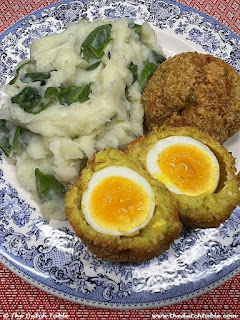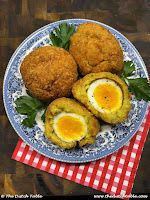 |
Sign offering 30
different sandwiches |
I just finished reading this month's issue of
Saveur, a high quality magazine dedicated to all things food. It is one of my favorite monthly reads, with articles that focus on eats from all over the world, exotic recipes within reach and writers that offer great cultural backgrounds on dishes, traditions and tools. This month's cover boasts "90 Handheld Meals From Around The Globe" and an article about "World's Best Breads and Condiments": it's the Sandwich Issue.
With the huge variety on sandwiches (
broodjes) and bread toppings we have in Holland, I was convinced we would be mentioned at least in one, if not in both articles. After all, the sandwich plays such an important role in the Dutch food culture that there are not one but two national
Tastiest Sandwich of the Year competitions. Holland, or the Netherlands, is one of the largest bread consumers of Europe. Many a tourist, when stepping inside a Dutch bakery, grocery store or sandwich shop, is surprised by the large amount of bread varieties and toppings to choose from. But for a country where two out of three meals mainly consist of bread, the variety is not so much an option as a necessity.
 |
| Broodje shrimp |
Sandwiches are therefore par for the course. Many people bring lunch from home in a small lunchbox or eat at a neighborhood sandwich shop or the company's cafetaria. A typical Dutch lunch will consist of a whole wheat sandwich with cheese or meat, a white sandwich with a sweet topping and a piece of fruit or a small yogurt to round off the meal. Boring? Not with all the choices one has to spruce up a slice of bread!
Did they cover the bread toppings? I wondered. Well, heck, how can you not? Whole grocery store aisles are dedicated to just that, ranging from sweet to savory and anything inbetween. "I bet you they featured
mice" I thought, those crunchy sugar-coated anise seeds that resemble the shape of rodents, with their little tail pointing upward. Or maybe coconut bread topping, those thin sheets of hot pink coconut paste that so many of us loved when we were young.
 |
| Chocolate hail and flakes |
But that might be too exotic.
Maybe they played it safe and only covered the chocolate hail and the flakes.
Or the fruit hail, jellybellies, pink or blue mice. Or maybe they didn't cover sweet at all, maybe they only featured savory spreads. A
broodje oxen wurst perhaps, or
filet americain, pickled liverwurst,
raw herring,
shrimp,
frikandel, warm sliced meat, or kroket?
Broodje bal? Smoked eel?
Or perhaps a cheese sandwich? But which cheese? Gouda, Edam, graskaas, meikaas, Old Amsterdam, Maaslander, Parrano, Westland or Waddenkaas? My head was spinning just thinking about all the different options and I felt bad for those Saveurders who would have to try and make sense out of all of this.
 |
| The Dutch Uitsmijter |
But guess what? Not a word. Not one mention of hail,
halfom or herring. Not even a hint on Holland's Sandwich of all Sandwiches, the
Uitsmijter. I went through the magazine twice, just to make sure I didn't miss it by accident. The closest we came is the mention of a Dutch crunch roll on page 46, which is supposed to resemble a
tiger roll.
It's a little bit our own fault of course. We don't half brag about our food like other countries do and it's almost like we're too humble to mention it. But maybe it's not that we're too humble, perhaps we just don't know where to start!
So to set things straight, and to get our fabulous Dutch food on the map after all, I'm suggesting these additions.
Global Sandwiches Agenda (pg 18)
On June 11, Holland celebrates
Luilak, a centuries old tradition predominantly popular in the northern part of the country. Youngsters mock late sleepers and try to prevent anybody from sleeping in on this Saturday morning by ringing doorbells, honking car horns and tying pots and pans to the back of their cars and bicycles and making a huge racket. Bakers prepare
luilakbollen, a sweet round roll with raisins and currants, as a specialty for the day. Whomever wakes up last is supposed to treat the family to
luilakbollen.
 |
| Zebras |
Regional Rye Breads (pg 36)
Rye bread is one of Holland's favorites bread choices. The sturdy, coarse slices of
roggebrood are used as sandwich covers (wheat bread on the bottom, sandwich topping in the middle and
roggebrood on top) or for those pretty, tasty breadbites called
zebras: alternate layers of softened cream cheese flavored with fresh chives between moist slices of rye bread.
Friesland's
roggebrood is darker and is made with whole rye kernels, Brabant's and Limburg's
roggebrood is made with rye flour instead and not as dense.
Split-pea soup is traditionally accompanied by slices of
roggebrood.
Give Us Bread (pg 46)
 |
| Dutch Crunch, or tiger rolls |
Thirty breads from all over the world grace these two pages but no Dutch loaf made it onto the list. What about our
tiger roll,
Frisian sugar loaf,
white rolls,
raisin rolls, casino bread, Waldkorn.......there are too many to mention! We're so bread-happy in Holland, it's hard to choose. See for yourself how many varieties there are, even per province:
http://www.brood.net/default.asp?id=851&pid=streekbrood
Sandwich City (pg 48)
The magazine covered the city of Philadelphia, but it could have easily chosen Amsterdam instead. Home to a large variety of sandwich shops, Amsterdam can also brag about having the largest variety of sandwich toppings that are unique to the city: broodje
halfom ( a white roll with two slices of Dutch pastrami and four slices of thinly sliced liver sandwich meat), broodje
osseworst (a raw oxen meat sausage, cold smoked, and spiced with salt, white pepper, nutmeg and mace), broodje
kroket (either
Van Dobben or
Kwekkeboom), broodje
Sal Meyer, broodje
warm vlees, broodje gezond.....The list goes on.
Special Treats (pg 52)
This is the spot for all those sweet Dutch bread toppings!
Hagelslag, gestampte muisjes, vruchtenhagel, schuddebuikjes.....
Classic Combination (pg 54)
Ah....the all too famous combo of ham and cheese. The French have their Croque Monsieur and the Dutch have their
Uitsmijter. Two slices of bread, butter, ham, cheese and two fried eggs on top. A little bit of lettuce, some pickles and a tomato on the side, this open-faced sandwich is the Kingwich under the sandwiches. Traditionally a lunch item, and fancy enough to be eaten with knife and fork, the
uitsmijter gained its name from being served as a "one for the road" after a night of partying. In order to indicate that the night was over, the host would get busy in the kitchen and prepare ham, cheese and fried egg sandwiches and send everybody on their way.
Uitsmijter literally means "throw out".
Nuts about It (pg 60)
Where is a mention of the ubiquitous peanut butter and chocolate hail Dutch sandwich? A standard for all kids, and many adults, the combination of salty peanut butter and sweet chocolate is sheer heaven. Bet Elvis never had one of those!
Finishing Touches (pg 76)
What better than a lick of
appelstroop on a cheese sandwich......the slightly tart flavor combined with a dense sweetness,
Appelstroop, a thick syrup made from reduced apple juice and sugar, is a staple in the Dutch kitchen. Its tangy, sweet flavor adds dimension to sandwiches, is used to flavor meat stews such as
zuurvlees and is the number one choice of topping for those big cartwheel-sized Dutch pancakes.
Nevertheless, Saveur's Sandwich issue was a good one. Wonderful sandwich ideas, great pictures, lovely breads and educational articles.....enough for this Dutch girl to sit and savor each page!


























